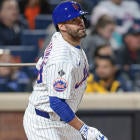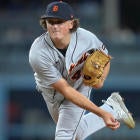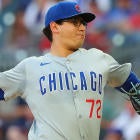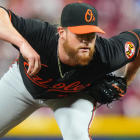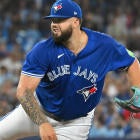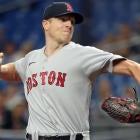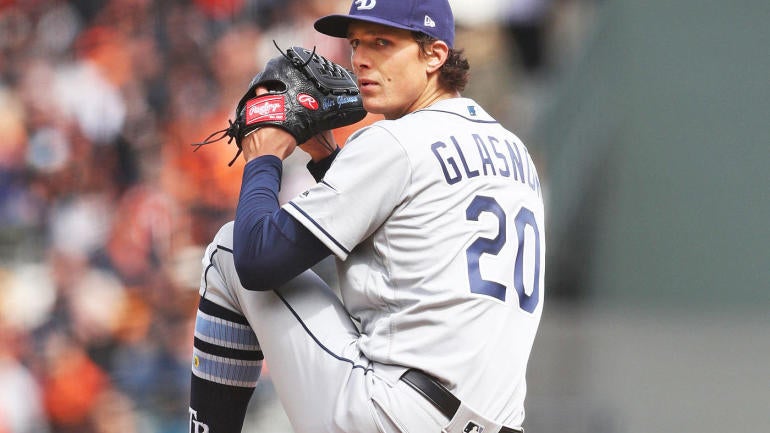
Opening Day of the 2021 MLB season is here, and more than even most seasons, there's a lot we just don't know about the season we're about to watch. 2020 was an unprecedented year for Major League Baseball, and with the COVID-19 pandemic still around, that still looms large -- as we were reminded Wednesday when Nationals GM Mike Rizzo told reporters the team had a positive test Wednesday that included four close contacts, which will inevitably shake up their Opening Day roster.
So, we're still dealing with potential disruptions as a result of COVID, and because the 2020 season was so strange -- a 60-game season, limited travel, non-balanced schedules -- it's harder than ever to know how much from last year really mattered. Did someone like Zach Plesac or Teoscar Hernandez really take a big step forward, or was it just a hot couple of months that would've regressed to the mean if given enough time? Did Patrick Corbin and Javier Baez really lose it, or did they just never get the chance to recover from a slow start? Oh, and what about 2019's breakouts -- can we write off Ketel Marte and Josh Bell because they couldn't back up their star turns in a 60-game season?
We've been grappling with those questions all offseason, and we'll finally start to get some answers to them when the games officially start Thursday. We'll get our first look at lineups we've been speculating about all spring Thursday. We'll see who most teams are looking at as their primary closers by the end of the first weekend, hopefully. And, by next week, we'll have seen at least one turn through the rotation for every team, getting our first real look at the starting pitching crop after a long offseason.
Oh, and we'll get our first extended look at the new baseball MLB will be using in 2021 -- a huge variable that could fundamentally change how the game is played this season. You'll need to remember not to overreact to the start of the season, but that doesn't mean there isn't anything we can learn from Opening Day or the first week of the season. Here's what I'll be watching out for on Opening Day and the first week of the season, beginning with the early returns on how that new baseball plays.
1. How does the new baseball play?
If you've been paying attention in recent years, you're undoubtedly aware of the way in which seemingly minor alterations to the manufacturing process of the baseballs MLB uses have had significant impacts on the way the game is played. Particularly, we've seen a record explosion in home runs in recent years, driven in no small way by a bouncier baseball. Call it "juiced," call it a result of changes in the manufacturing process, or whatever else, but the results have been clear.
And before spring training, we learned MLB had made "minor alterations" to the baseball that would purportedly cause the ball to travel "one to two feet shorter on balls hit over 375 feet." We saw some reporting during the spring that pitchers were already aware of the changes, with Blake Snell commenting on thicker seams that made it easier to grip the ball. My initial thought when this was announced was that the impact would be relatively minor, but may impact some players rather significantly -- guys like DJ LeMahieu and Cavan Biggio, who hit an inordinate amount of their home runs just over the wall could see a few more of those die at the warning track.
Surprisingly, the ball was put into play in spring training (mixed in with some leftover baseballs from the 2020 season), but the apparent effect even early on in spring was even more surprising:
I took a look at spring training data going back to 2016 looking for home run pace -- HR/(AB - K) -- and there’s no sign of it slowing down in 2021:
— Chris Paul Towers (@CTowersCBS) March 11, 2021
2021: 4.45%
2020: 4.08%
2019: 4.42%
2018: 4.09%
2017: 3.62%
2016: 3.61%
Home runs were becoming even more frequent, and that trend held true in spring training. And The Ringer released a study Wednesday indicating that, as the new ball was seemingly worked into the mix even more as spring went on, the home run rate on batted balls only grew. What's going on here?
Well, the new balls apparently did have more drag than previous years' -- The Athletic's Eno Sarris noted that batted balls hit over 100 mph with a 24-32 degree launch angle traveled 10 feet less than they did in previous years. That's a pretty significant change. So, how did the home run rate go up?
It's hard to say for sure yet, but it seems like the answer is this: While the new ball has more drag, it also jumps off the bat harder -- average exit velocity was up 0.8 mph this spring. And, it appears as if that effect is greater than the effect of increased drag on those batted balls.
The new ball also moves more out of pitchers' hands, with The Ringer's study finding that fastballs gained an average of 0.45 extra inches of vertical movement, while curveballs added 0.3 inches. That led to a higher whiff rate on such pitches and presumably played a role in spiking the strikeout rate leaguewide to nearly 25.0% this spring -- a record high level. And strikeout rates tend to be higher in the regular season than in the spring.
So, early returns suggest we could be looking at an offensive environment with more strikeouts and more home runs, the exact opposite of Rob Manfred's publicly stated hopes for a game with more "action."
Of course, we're still dealing with incomplete data sets from the spring -- not every spring park has Statcast data available, and we can't know for sure when the new balls were being used. The evidence points in this direction, and we'll start to get our first set of full data beginning Thursday. We'll need more than just one day to know for sure, but it shouldn't take long to either refute or corroborate these findings. And the impact could be incredibly significant on how Fantasy Baseball operates in 2021 -- though obviously, it's hard to know exactly who will be most impacted if these changes do stick.
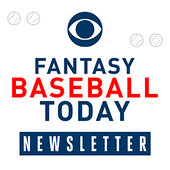
Fantasy Baseball Today Newsletter
Your Cheat Code To Fantasy Baseball
You're destined to gain an edge over your friends with advice from the award-winning FBT crew.
Thanks for signing up!
Keep an eye on your inbox.
Sorry!
There was an error processing your subscription.
2. What do lineups look like?
We can only learn so much from spring lineups when some teams will stick guys in the leadoff spot to try to get them an extra plate appearance every game if they think they need more work, while others will only play starters a few innings at a time, and still others will experiment with a different look nearly every game. Lineups aren't static things even in-season, but in spring especially, we'll see a lot more variance in how players are deployed.
However, with the games set to start counting, we'll finally get some tangible information about how teams view their lineups. And that can have a significant impact on Fantasy value, and not just for run production and lineup protection reasons -- if you believe in the latter, at least. With each lineup spot you move up, you gain around 16-20 plate appearances over the course of a full season, so the difference between Victor Robles batting first vs. eighth could be over 100 plate appearances. Stolen base rates are historically tied to lineup position, too -- players tend to run more from the No. 1 and 2 spots than No. 3 or 4, and there actually tends to be a significant difference in how often players run from the No. 7 spot vs. No. 8, as they are less likely to attempt a steal with the pitcher up.
The Opening Day lineup may not be the lineup a team uses in their second game, and it almost certainly won't be the same as the one they used in their 83rd game. But it's our first real sign of how players will be used.
3. Who is throwing faster or slower?
We've been paying close attention to Patrick Corbin's fastball velocity all spring, given how much his slip in 2020 seemed to impact his performance. Similarly, I was tracking Casey Mize's velocity, because he wasn't throwing nearly as hard as expected last season, and struggled as a result. Mize's velocity was consistently up 2+ mph, while Corbin's seemed to be trending up as we got closer to Opening Day, and both were very promising signs.
And velocity is the kind of stat that tends to stabilize very quickly. Sure, some days a guy just doesn't have it, or some days they're extra fired up. But, since it's a direct measure of what the player is doing physically, there isn't a ton of noise here. If a player's velocity is up in his first start or two, that's usually a good sign. Early velocity dips are harder to parse, because many pitchers take some time to get up to their top speed, but they're still worth noting.
I'll be watching the likes of Corbin, Mize, Stephen Strasburg, Justin Dunn, Charlie Morton, Carlos Martinez, Jameson Taillon, Mitch Keller, Mike Foltynewicz, and others to see where they are at early on. And, there will always be a few players who surprise one way or another early in the season, too.
4. Who is throwing new pitches?
Tyler Glasnow's got a new slider/cutter he's been working on in spring, and there have been times when it's looked unhittable. He's been looking for a third pitch to complement his devastating fastball/curveball combo, and if the slider can be that pitch, it could solve some of his consistency issues. That's just one example of a high-profile player toying with a new pitch, and while it could push Glasnow up a level, there's only so high he can rise from where he's at. The more interesting players to watch in this regard are guys like Carlos Rodon, who like Glasnow, has long worked to expand his arsenal to complement his fastball and slider. He's had a changeup for a while, and apparently, he added a curveball this offseason he's looking to work in around 8-10% of the time. For a guy who has never been short on talent but just needed to refine his approach, that could be game-changing.
We'll try to keep track of pitchers integrating new pitches early this season because it could be the sign of an impending breakthrough, just like new velocity readings can be. Nothing is guaranteed, but with pitching at such a premium, identifying such players before the crowd can go a long way to helping you compete for a title.
5. Who is closing games?
There aren't many pitchers I feel confident are both good and have a secure ninth-inning role heading into the season, because there are so many situations that are seemingly totally up in the air right now, especially from the outside looking in. For instance, Cleveland potentially has three impact closer candidates in James Karinchak, Emmanuel Clase, and Nick Wittgren, and we don't seem to have any indication as to who is preferred for the role. Wittgren might be the least talented of the trio, but there's been buzz from beat writers all spring that he might end up the closer, with Karinchak and Clase being deployed as shutdown high-level relievers in non-save situations.
One weekend won't tell us everything about who is closing, and there will undoubtedly be at least a few teams who either don't get a save chance for the first week or the season or who use multiple players in their first few chances, further muddying the waters. But at least we'll start to get some actionable intel beginning Thursday. Earlier, I ranked each closer into tiers based on job security.
6. Will there actually be a universal DH?
It seems next to impossible that this will actually happen, but I just saw this tweet slide down my timeline, so I had to address it:
Yu Darvish, who hates hitting, on the possibility of #MLB & players agreeing to universal DH tonight before Darvish has to bat in his Opening Day outing:
— Scott Miller (@ScottMillerBbl) March 31, 2021
"I have all the trust that MLB will make that happen."
Wouldn't that be an amazing turn of events? We spend all spring preparing as if there will be no DH only to have them sneak an agreement under the wire? As someone who hates watching pitchers hit almost as much as Yu Darvish seems to hate doing it himself, that would be a heck of an early Opening Day present. Even if it might cause a bit of chaos in Fantasy leagues.
Just for what it's worth, here's a quick list of players who would benefit most from this kind of miracle:
- Dom Smith
- Garrett Cooper/Jesus Aguilar/Adam Duvall
- Ryan Zimmerman
- Avisail Garcia/Jackie Bradley/Lorenzo Cain
- Dylan Carlson
- Nick Senzel/Shogo Akiyama/Aristides Aquino
- Daulton Varsho
- Will Smith
- Wil Myers
- Sam Hilliard
- Brandon Belt/Buster Posey














